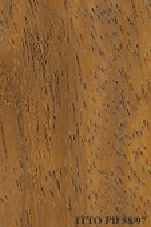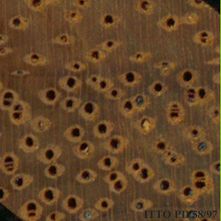
IATANDZA (Albizia ferruginea)
Trade Name
Iatandza
Scientific Name
Albizia ferruginea Benth.
Family
LEGUMINOSAE
Common Names
Murase (Togo); Kulo (Ghana); Awiafu-samina (Ghana); Yatandza (Côte d`Ivoire); Muchole (Uganda); Omulera (Tanzania); Omulera (Kenya); Yatandza; Sakachi; Newei; Musase; Muchole; Kulo; Iatandza; Evuvus; Ayinre; Awiemfo-samina; Awiafu-samina; West african albizia (United Kingdom); Okuru (Zaire); Elongwamba (Zaire); Zazangue (Angola); Sifou-sifou (Congo); Evouvous (Cameroon); Ayinre-ogo (Nigeria); Okuro (Ghana); Aviemfo-samina (Ghana)
Scientific Name Synonyms
Inga malacophylla A. Rich.; Inga ferruginea Guill. & Perr.; Feuilleea ferruginea (Guill. & Perr.) Kuntze; Albizia malacophylla (A. Rich.) Walp.
Description Of The Tree
Botanical Description
The tree reaches a height of 40 m and more, with diameters up to 100 cm. The bole is straight and cylindrical, from 10 to 13 m in length, without a buttress.
Natural Habitat
Albizia ferruginea is widely distributed in secondary forests, dry dense forests and sandy soils.
Natural Distribution
West Africa, from Senegal to the Democratic Republic of the Congo and Angola.
Wood Identification
Anatomic Description Of Wood
Wood diffuse porous. Occasionally vessels exclusively solitary (over 90%). Tangential diameter of vessel lumina 200 micras or more (large). Vestured pits. Vessels per mm2 less than 6 (rare). Simple perforation plates. Vessel-ray pits similar to intervessel pits Paratracheal axial parenchyma scanty and/or vasicentric. Axial parenchyma lozenge-aliform. Prismatic crystals in chambered axial parenchyma cells and/or in fibers. 3 to 4 cells per parenchyma strand. 4 to 10 rays per mm (medium). Rays non-storied. Rays 1 to 4 seriate. Homogeneous rays and/or sub-homogeneous rays (all ray cells procumbent). Septate fibers present. Fibers with simple to minutely bordered pits.
-
 Wood Macro Photo Tangential Plane
Wood Macro Photo Tangential Plane
-
 Wood Micro Photo Of Transversal Section
Wood Micro Photo Of Transversal Section
Availability
Cites Status
Unrestricted
General Wood Description
Color
The sapwood is pale yellow, it has a thickness of 5 cm. The heartwood is yellowish brown to dark red brown, with golden tinge, sometimes dark streaks, it is clearly demarcated.
COLOR INDEX (1=Black, 7=Light yellow,white)
4
Grain
The grain is slightly but systematically interlocked.
Texture
The texture of the wood is frequently coarse.
Natural Durability
Durable to decay; this species can be utilized without preservative treatment for exterior joinery or similar uses. Resistant to termites attack. Heartwood is resistant to Lyctus attacks.
Natural durability index (1= Very high durability, 7=Vey low durability)
1
Internal Growth Stresses
No growth stresses are reported in this species.
Silica Content
Silica Content: This timber is reported to have a negligible silica content. Silica contents over 0.05% may affect wood processing. Silica Value: 0.01
Resistance To Impregnation
Difficult to treat with only a low penetration of the preservative products.
Wood Physical Properties
Basic Density or Specific Gravity (O.D. weight/vol. green) (g/cm³)
0.55
Air-dry Density (Weight and volume at 12%MC) (g/cm³)
0.60
Total shrinkage Tangential (Saturated to 0%MC) (%)
4.8
Total shrinkage Radial (Saturated to 0%MC) (%)
2.8
Drying Defects
Ease of Drying: Air seasoning is reported to be moderate. Drying Defects: Risk of bowing and twisting is reported.
Recommended Dry Kiln Schedule
FR-7
Dimensional stability ratio (Total Tangential Shrinkage %/Total Radial Shrinkage %)
1.7
Wood Chemical Properties
Wood Mechanical Properties
Bending Strength (MOR),12%MC (kgf/cm²)
822
Stiffness (MOE) 12%MC (kgf/cm²)
132503
Compression parallel to fiber 12%MC (kgf/cm²)
514
Compression perpendicular to fiber 12%MC (kgf/cm²)
64
Shear strength radial 12%MC (kgf/cm²)
81
Janka hardness (side) 12%MC (kgf)
442
Janka hardness (end grain) 12%MC (kgf)
546
Workability
Sawing
It is easy to saw.
Rotary Veneer Cutting
Suitable for peeling if treated.
Sliced Veneer
Suitable for peeling if treated.
Blunting Effect
Slight blunting effect; ordinary tools can be used for sawing and machining.
Machining
Machining of this species is reportedly easy.
Planing
Moderately easy; tools must be cautiously sharpened.
Moulding
Easy; no particular problems.
Turning
30
Boring
Easy; no particular problems.
Mortising
Easy; no particular problems.
Nailing
No particular problem.
Gluing
Glues well if basic gluing technical rules are followed.
Sanding
Easy to perform; it gives good results.
Polishing
Needs pre-coating.
Steam Bending
This species can be used for steam bending.
Response To Hand Tools
No particular problems.
REFERENCED USES
End Uses Summary
HOUSING GENERAL, beams, joists, boards, flooring, parquet, frames, steps, panelling, fittings, shutter boards, FURNITURE AND CABINETS, luxury furniture, cabinets, PLYWOOD AND VENEER, faces, cores, TURNING, ornaments, turned furniture, cutlery, lasts, OTHER AND MUSICAL INSTRUMENTS, handicrafts, door core, coffin
General Housing
- 10 - Silica in Timbers
Beams
- 11 - Prospect: The wood database
Joists
- 12 - Tropical timbers of the world. Part I-Tropical American Species
Boards
- 13 - Dry kiln schedules for commercial woods. Temperate and tropical. Section III. Latin American (Mexico, Central, and South America) Woods–Conventional Temperatures
Flooring
- 14 - Handbook of Hardwoods
Parquet
- 15 - Empire Timbers
Frames
- 16 - Woods of the World
Steps
- 17 - Tree Conservation Database
Paneling
- 18 - W3TROPICOS Missouri Botanical Garden
Fittings
- 19 - Silica in Timbers
Shutter Boards
- 20 - Prospect: The wood database
Furniture Cabinets
- 21 - Tropical timbers of the world. Part III-Southeast Asian and Oceanian Species.
Furniture, Luxury
- 22 - Dry kiln schedules for commercial woods. Temperate and tropical. Section IV-Asian and Oceanian Woods
Cabinet
- 24 - Empire Timbers
Panels, Veneers
- 25 - Directory of Timber Trade Malaysia
Faces
- 26 - Annual Review and Assessment of the World Timber Situation 1998-ITTO
Cores
- 27 - Embassy of Brazil in Japan
Turning
- 30 - Embassy of Honduras in Japan
Ornaments
- 31 - Embassy of Colombia in Japan
Turned Articles
- 32 - Embassy of Cote d`Ivoire in Japan
Knife Handles
- 33 - Embassy of Gabon in Japan
Lasts
- 34 - Embassy of Indonesia in Japan
Handcraft
- 66 - Maderas latinoamericanas. VII. Caracteristicas anatomicas. propiedades fisicomecanicas, de secado, y tratabilidad de la madera juvenil de Cordia alliodora (Ruiz & Pav. Oken.)
Door Cores
- 76 - Descripción General y Anatómica de 105 Maderas del Grupo Andino.
Coffin
- 78 - Amazonian Timbers for the International Market
Please Provide Information To View Producer Information